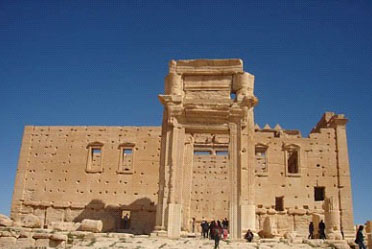PALMYRA, (ST) – There is hardly anything in Palmyra only attracts the attention to the city that dazzled the West and the East with its architectural arts, its aesthetic and optical excellence as far as the eye can see, thanks to its rich archaeological buildings, palaces and temples, the most important is Bell, which still remains number one of the most beautiful ruins of the Middle East.
It has been written and said a lot about the temple until it becomes well -known locally and internationally which means that it has taken the right of definition in terms of the archaeological side according to an expression by the tourist guide, Yasmin Shahla.
Mrs. Shahla prefers talking about the temple as she heard of visitors who called it as the Badia (desert) icon. The temple consists of tetragonal- shaped courtyard that is surrounded by a portico with columns of Corinthian capitals lined behind each other in the same manner high and organized in a civilized manner that makes the beholder to it amazed by the consistency of those columns with each to the degree of fondness.
Some of the visitors to the temple feel the importance of mathematics to understand that engineering and innovation in the antiquities of ancestors, said Walid Sa’id, a visitor, who already saw the temple.
“I did not like math but once I visited this temple I began fixing my eyes in those columns and all sides of the temple which take the forms of triangles and so forms and engineering arts until I began to understand some of the construction of mathematics as if the builder of this great edifice were aware how the whole world is based on mathematical equation or physical issues that need a long time to understand how to solve them and the need for reflection and patience until we receive our intention,” Mr. Sa’id added.
It is evident that the history of the temple dates back to the first and second centuries AD. It contains a yard, three corridors, a campus and remains of a holy pond still exist, a table and an altar. Apart from being an archaeological valuable site for the amateurs of archeology and history, it is also a tourist catalyst and attracts the attention many people who could feel comfort, quietness and the beauty of life when they visit it, according to Nazir Melchonian of Aleppo.
“When I go to that part of land, I feel as if I was in a legendary and fictitious place, as if I weren’t on the ground because it is located in the desert, sand covers its surroundings and the multiform stones fill its outside yard except for the rays of the sun falls upon as if it were devoted to the temple alone. The one would think that the universe has a sole color, yellow, in the sky and the earth, and even in winter it has a special flavor as the atoms of sand that scatter in the air look like as threads of gold that embrace the columns, at that moment the one feels that he is capable of holding the wind in his hands and making it adapt as he pleases. A feeling you can not be earned only in that beautiful temple,” Mr. Melchonian concluded.
Sh. Kh.

